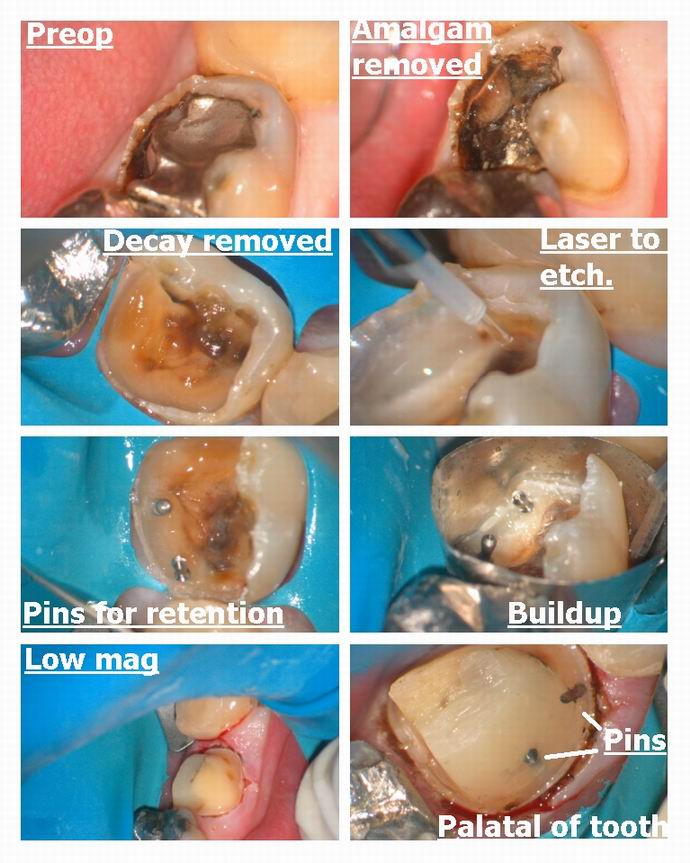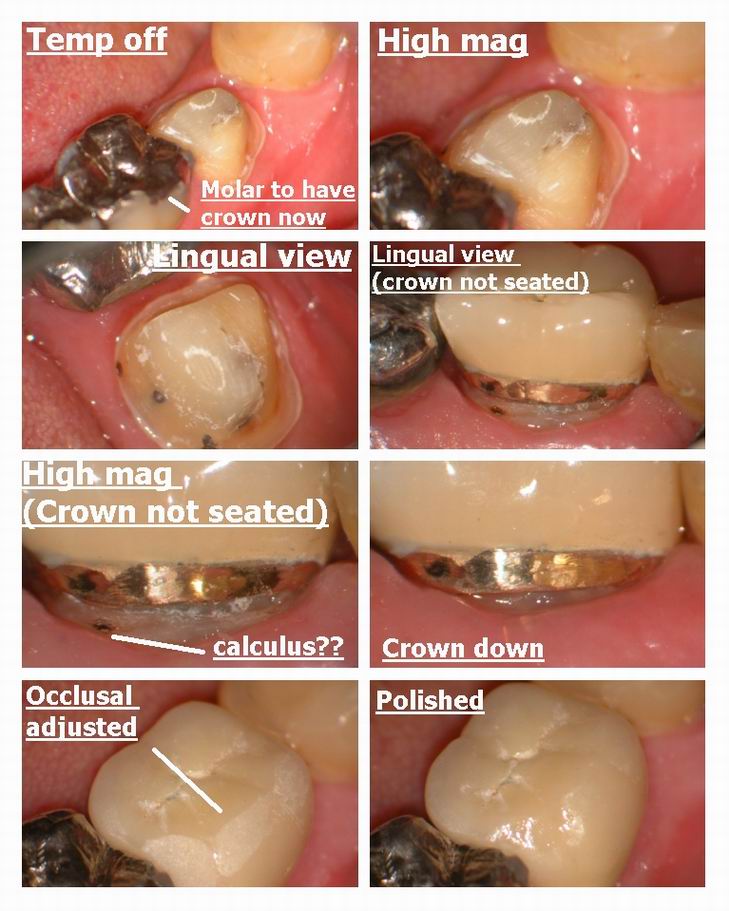Forums › Erbium Lasers › General Erbium Discussion › What would you do
- This topic is empty.
-
AuthorPosts
-
Glenn van AsSpectatorHi there folks: Patient came in and wanted me to fix the lower left 2nd molar today.
The lingual had fractured and there was ALOT of decay under the old amalgam.
I removed the old amalgam and wondered it was pulpal.
I got all the decay out but only a solid buccal cusp left.
I didnt know whether to do….
1. Large resin restoration
2. Pin retained core and crown
3. Endo plus post , core and crown
4. Large resin buildup , no pins and then crown.You can see I chose pins and a resin after laser etching the tooth structure. I have heard LOTS of people mention that pins may even weaken cores but I know that when I put them in on cases like this that the core NEVER EVER comes out during the impression or during the temporary fabrication.
I used the laser to help with tensile strength of the buildup and to sterilize the tooth.What would you have done……….I just can justify no retention but I am sure many of you do it daily with better success than me.
All the best……….
Glenn

PatricioSpectatorGlenn,
I do not have a better way but I likely would have placed slots more or less where you have the pins for retention of the resin and I feel I would achieve the same result. Possibly this is slightly easier.
Pat
wiemsSpectatorI see this type of thing a lot, and when I do, I go for the ceramic onlay. I knw some people would say “not on a 2nd molar”, but most ceramic failures are due to a bonding problem. You obviously can acheive a dry field, since the remaining tooth is supragingival and you have a rubber dam in place. I have tons of these out there in Empress 1 up to 11 years old, but I have recently switched to Authentic pressed porcelain due to some positive feedback on the material from my lab. They say it’s stonger than empress. Back to the prep, I would take down the buccal cusp also, make sure that bothe M and D contacts are broken, and bond te ceramic to the acre of dentin and enamel that you have left. I would temporize with some fermit or triad molded and locked between the adjacent teeth, tell the patient that he or she is off the hook for flossing for the next couple of weeks, and then bond that baby in at the delivery appointment. It works great, and the tissue stays much healthier around the ceramic due to the undetectable supragingival margins.
Glenn van AsSpectatorHi Wiems………thanks for your input. Here is a case I did on Thursday , interesting that you put your post up.
A lady had an onlay placed around 4 years ago and it totally came unbonded. There was alot of decay under it and I placed 2 pins and laser etched and then did a full coverage crown.
The bonding process definitely helps improve fracture resistance but all to often if not done with alot of precision and attention to detail under high magnification, the bonding process can be poor or sloppy.
If done well I agree bonding is the way to go. IF not most cements have no fluoride release and are waiting for failure.
Hope this is interesting and good thread.
Rubber dam and careful bonding technique to ENAMEL are crucial in the success.
In closing I still fell shaky relying only on a bond for my retention of the crown, still feel shaky about 1 and 2 step bonds (just heard a lecture from Dr. Franklin Tay that confirmed some of my fears yesterday) and still try to do as much as possible to hold crowns on.
Cya
Glenn
[img]https://www.laserdentistryforum.com/attachments/upload/Resize of Onlay replacement_p1_p1.JPG[/img]
[img]https://www.laserdentistryforum.com/attachments/upload/Resize of Onlay replacement_p1_p2.JPG[/img]
wiemsSpectatorHey Glenn – – That was a nice recovery from a not so pretty clinical situation. In all of the porcelain onlays that i have done, i have seen them debond from time to time. My thoughts are that there was decay left there from the previous prep, which, of course, would compromise the bond. There are many factors I am sure that you know that will cause bond failures, namely improper porcelain etch, silanation, bonding technique, contaminated tooth surface, improper isolation, occlusion, prep design… the list goes on. A failure that I see more often is the failure of large core buildups bonded entirely to dentin. Although I think that the pins will help hold the core in place, you are still left with the situation where you have to now put your crown margin another 2 mm beyond the buildup ideally to be on sound tooth structure, which most likely paces your margin on cementum and quite subgingival. I guess the laser will help with getting your impression, but the sulcus will never be as healthy long term as it would be if you went with the onlay to start. I am not going to say that I haven’t redone work that failed, but I am comfortable with the success that I see with bonded full coverage porcelain onlays.
Did Dr. Tay say anything about the self etching bonding agents such as simplicity or I-bond?
Glenn van AsSpectatorDr. Tay was not overly impressed with these bonding systems especially for dual cure purposes.
I am not an expert on the bonding of porcelain onlays.
This one failed at the cement border, it was leaking .
Luckily it was salvageable and one of the few that wasnt pulpal…….most are just mush as you know when you get them off.
I know that putting pins in is frowned upon but I always am scared to place the core on dentin alone. Then you pull the temp of and out comes the core.
ALot of people do endo on these but I cant justify it if the decay isnt pulpal.
The tissue will heal nicely here, and I will take pics but your points are very valid.
Todays speakers included Bob Winter , John Kois, and Harold Heymann and sell as John Sorensen.
John is coming to the office tomorrow so I can show him the scopes as he wants to document procedures more and has been emailing me about scopes.
All the best and great points
Glenn
Robert Gregg DDSSpectatorHi Glenn,
I don’t talk much about my bonding experiences since there are so many Gurus out there that speak reasonably well on the subject.
I started bonding DICOR to the dentin and enamel in 1985 using total etch. Learned from Ray Bertolotti.
I stopped using pins at that time too.
I learned on my own and with Ray’s help (John Kanca wasn’t anywhere around then) how to get those suckers to stick and stay without decay. Now I bond Empress to anything that ins’t deep sub-gingival, even second molars. “Deep anatomy” and occlusion are key.
If not a bonded Empress, then a PFM or FGC with a long bevel and no BU at all.
I have never been impressed with SE and don’t use it without a TE or laser etch technique thrown in.
Bob
wiemsSpectatorHey Bob,
What do you mean by “deep anatomy”?
Glenn van AsSpectatorHere is the insert of the crown on the first post on this thread which I did today. Look how I could visually see when I had adjusted the contacts enough to allow for the lingual margin to go into place. The crown seated without the need for an explorer.
WHat is interesting is how the patient now asked me about the rest of the amalgams on that side (after watching me seat the crown on that tooth) and is prepared to go ahead with a crown on the molar and two composites on the premolars (I had to really talk him into the first crown).
This is constant with the scope and the video from it, patients demand to have other work (usually old amalgams) removed when they see the crowns being placed at high mag.
glenn

Robert GreggParticipantHi Andy,
By “deep anatomy” I mean that I don’t want any secondary or tertiary occlusal anatomy that makes them look pretty, but are going to become interferences sooner or later.
Kind of hard to describe in words, but I want the incline planes to be concave versus convex to better accept the opposing tooth’s working cusp.
I want my contacts in real tooth structure if at all possible, or in the proper cusp tip position, and little in the central fossa on seating.
Bob
-
AuthorPosts
